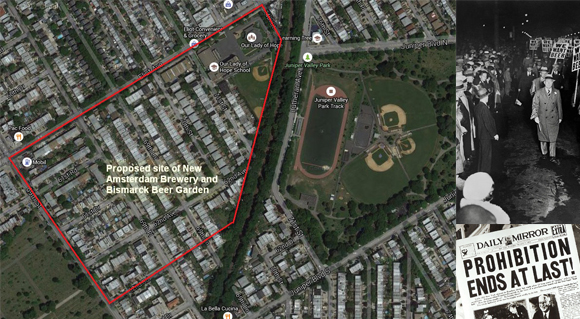Peruse the local newspapers from the 1930s for articles about our area, and you may notice something very interesting. At one time, the largest beer garden in the United States had been planned for Middle Village!
The New Amsterdam Brewing Company, based in Manhattan and invested in by many wealthy businessmen of the time, was patiently waiting for the Volstead Act, which authorized Prohibition, to be repealed in 1932. NABC had planned to be the first brand new “modern” brewery in the NYC area when repeal finally happened. NABC acquired the westernmost 22-acre portion of Arnold Rothstein’s “Phantom Village” site in Middle Village, which stretched west to east from 69th Street to the CSX tracks. The northern border of the property was Eliot Avenue and the southern border was 62nd Road. The property was situated west of today’s Juniper Valley Park, which in 1932 was in its earliest planning stages, with its land not yet fully acquired by the City of New York from the Rothstein estate.
The NABC had plans to invest $2.5M into the construction of a modern brewery and what was expected to be the country’s largest beer garden. Herbert L. Noll, a third generation brewer and president of the company, told newspapers at the time that seating capacity at the Bismarck Beer Garden would be roughly 5,000 in good weather and the indoor portions would accommodate 2,500 in bad weather. The brewery would cover 1/3 of the property and be built at the eastern end of the lot, which included the land where Our Lady of Hope stands today. Noll forecasted that initially, the brewery’s annual production capacity would total 250,000 barrels, but that it would have the ability to expand its operations to produce 500,000 barrels should the need arise. The site would also host a swimming pool and provide ample parking space. The South Elmhurst Civic and Improvement Association came out wholeheartedly in favor of the development and its president publicly wished for more beer gardens to locate in Queens.
In late 1932, newspapers were reporting that an artesian well was in the process of being dug at the site. Noll suggested that it would take 8 months to build the brewery and another 3 months to install the equipment needed to brew. Capitol Hill watchers were expecting repeal of the Volstead Act in April 1933, but NABC planned to produce malt beverages in the meantime should that be delayed. Hundreds of unemployed men reportedly showed up at the brewery site in December 1932 in hopes of landing construction work. It was projected that once it was up and running, it would employ 300 full time workers.
Water was reached at a depth of 105 feet and the flow itself was discovered to be 30 feet deep. The artesian well was tested in February 1933 and found to be suitable for brewing purposes. The water was tested chemically and determined to be pure and fine. It flowed from the well at a rate of about 700 gallons per minute.
Noll had taken a trip to Europe to study German, Czech, Swiss, French and Belgian beer making methods in the fall of 1932. As he toured, several experts approached him and asked to work in America for his company. Noll refused, vowing only to employ American beer makers, believing that they better understood what the American public wanted to drink.
After a survey of the land was completed, the Chanin Construction Company was chosen to build the brewery with Schwartz Laboratories overseeing the engineering of the equipment. Architect C. Dale Badgeley was hired to design the building. It seemed as though all systems were go.
The Volstead Act was repealed when the 21st Amendment to the U.S. Constitution was passed by Congress on December 5, 1933. However, the construction of the brewery and beer garden never happened. Why it didn’t is a mystery. There are no mentions of the Bismarck Beer Garden, New Amsterdam Brewing Company, Herbert L. Noll or a brewery in the Middle Village/Maspeth/Nassau Heights area in newspapers after March 1933.
An aerial view of the property shows that it was still largely empty nearly two decades later in 1951. Instead, the land that the country’s biggest beer garden was to sit on is now 100% developed with houses, a gas station, a church and a school.




